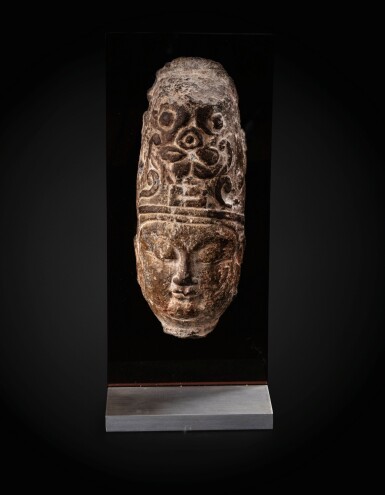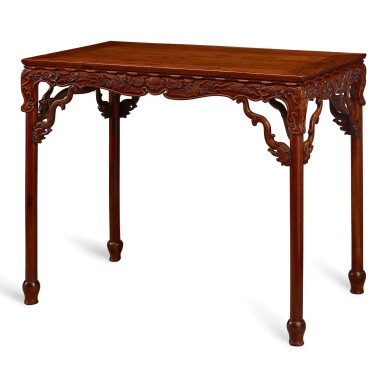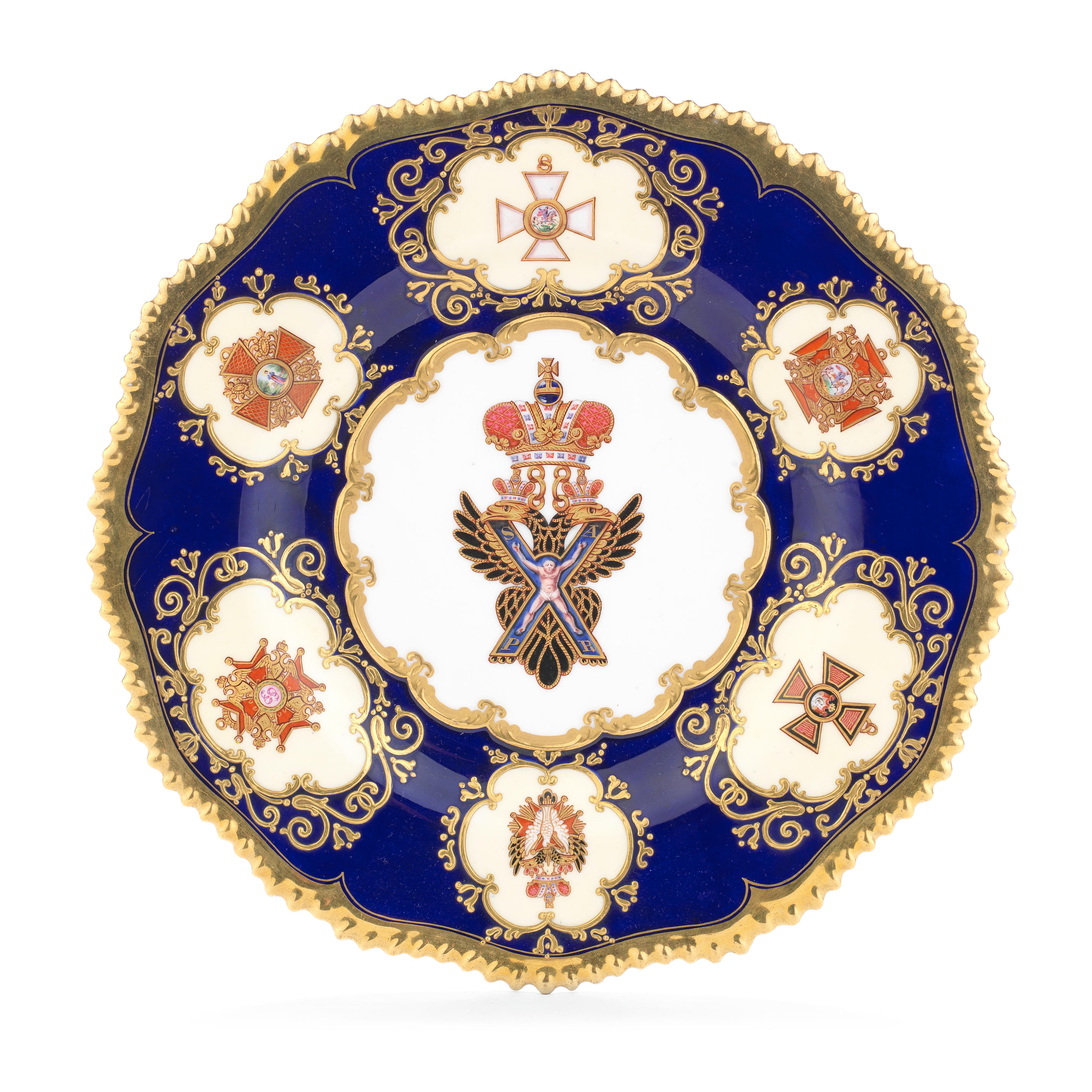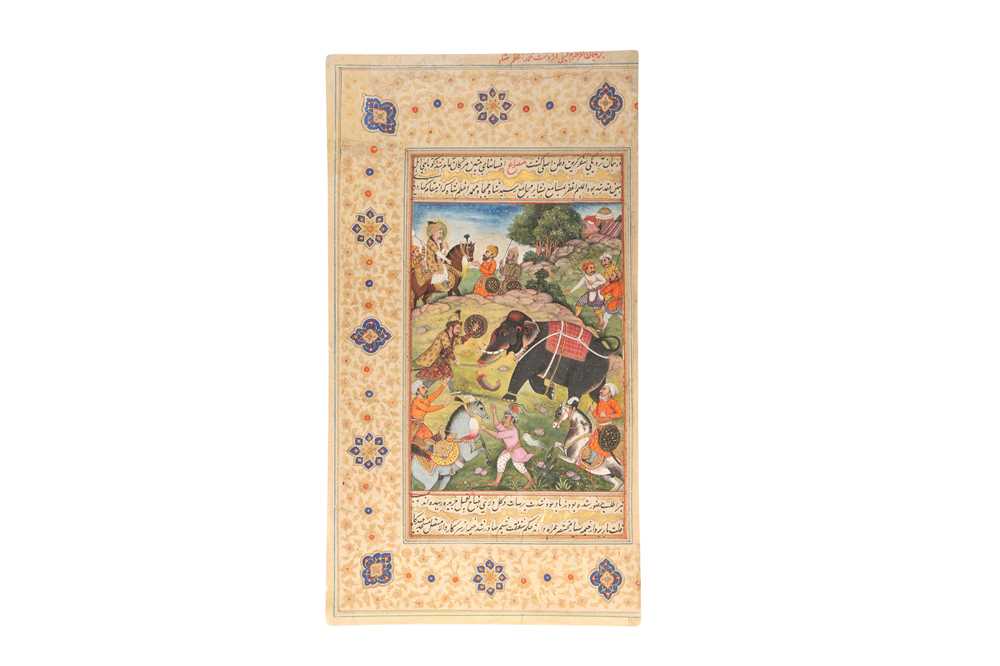Property from an Important Japanese CollectionA superbly carved polychrome limestone figure of a Bodhisattva,Northern Qi dynasty日本顯赫收藏北齊 彩繪石灰岩雕菩薩立像
display standh. 91 cm, overall h. 115 cmCondition reportThe figure is in overall good condition; As visible in the catalogue illustration, there are minor bruises and flakes to edges and extremities; Overall with surface wear and losses to the pigments consistent with age and type.
總體品相完好;如圖錄照片可見,背光及佛像邊沿處有些許正常磕碰;石雕常見之表面劃痕小碰撞及脫彩。
In response to your inquiry, we are pleased to provide you with a general report of the condition of the property described above. Since we are not professional conservators or restorers, we urge you to consult with a restorer or conservator of your choice who will be better able to provide a detailed, professional report. Prospective buyers should inspect each lot to satisfy themselves as to condition and must understand that any statement made by Sotheby's is merely a subjective, qualified opinion. Prospective buyers should also refer to any Important Notices regarding this sale, which are printed in the Sale Catalogue.NOTWITHSTANDING THIS REPORT OR ANY DISCUSSIONS CONCERNING A LOT, ALL LOTS ARE OFFERED AND SOLD AS IS" IN ACCORDANCE WITH THE CONDITIONS OF BUSINESS PRINTED IN THE SALE CATALOGUE.ProvenanceHirano Kotoken, Tokyo, 1983.The Chinese Porcelain Company, New York, 1991.
平野古陶軒,東京,1983年 The Chinese Porcelain Company,紐約,1991年 ExhibitedAncient Asian Sculpture, The Chinese Porcelain Company, New York, 1991, cat. no. 10.
《Ancient Asian Sculpture》,The Chinese Porcelain Company,紐約,1991年,編號10Catalogue noteThe Northern Qi dynasty (550-577) was one of the most vibrant periods in the history of Chinese art, both religious and secular, as its openness towards foreigners, their ideas, beliefs and goods, immensely enriched the local cultural climate. Buddhist sculpture experienced perhaps its most glorious moment in this period. While in the Northern Wei period (386-534), manners of depiction had only just been adapted from their south and central Asian prototypes, in the Northern Qi they had matured and developed into native styles. Yet, they still emanate the seriousness of strong religious beliefs and had not yet moved towards the pleasant and more decorative imagery of the Tang dynasty (618-907). The present sculpture is one of the classic bodhisattva images of the period when sculptors were less interested in rendering the three-dimensional physical side of a deity figure than in capturing its spiritual message through delicate facial features and gestures. Bodhisattva figures of related type became popular through the patronage of the Northern Wei imperial family, who commissioned the carving of rock caves in Longmen and Gongxian, both in Henan province, in the first quarter of the 6th century, which typically show seated or standing Buddhas flanked by two bodhisattvas. Besides these massive stone carvings in cave temples, many free-standing steles, also often with two such bodhisattva figures on either side of a central Buddha statue, were commissioned in that century, which followed the artistic language introduced by these grand Buddhist cave sculpture projects, which exerted an overwhelming influence on Chinese sculpture of the period in general.
This majestic bodhisattva stands out because of its fine, even facial features and the attention paid to its elegant, decoratively stylised crown and garment with loose scarves and knotted ribbons. The low-relief carving style and almost complete disregard for the shape of the body under the garments are characteristics of the Northern Qi period. Although many features were introduced to Buddhist stone carving in the preceding Northern and Eastern Wei (534-550) periods, stylistic variants would naturally have been introduced by locally working sculptors.
In its overall shallow relief treatment of the body, with only the hands protruding in higher relief, this figure shows similarities to many bodhisattvas that flank Buddhas at Gongxian, which are depicted with similarly parted hair, rudimentarily indicated under similar crowns decorated with lotus petals and circular jewel-like discs, with similar neck ornaments, garments, and mandorlas behind the heads. Compare, for example, a Northern Wei Bodhisattva figure from the north wall of cave 1 of the Gongxian cave complex, with scarves are similarly crossed through a disc, illustrated in Gongxian shikusi [Cave temples of Gongxian], Beijing, 1963, pl. 69; in Zhongguo shiku. Gongxian shikusi [Chinese caves. Gongxian cave temples], Beijing, 1989, pl. 69, and p. 209, figs 13-1 to 13-5, where it is compared with related figures from other walls in cave 1 and from other caves; and in Gongxian shiku [Cave temples of Gongxian], Beijing, 2005, p. 24, fig. 36, and p. 33, fig. 55.
Related bodhisattva figures, with similar crowns and garments, but also with more stylised garment folds, can also be seen in the Longmen caves, for example, on the north wall of the Putai cave, which dates from the Northern Wei period, see Longmen shiku [Longmen caves], Beijing, 1980, pl. 105.
The sharply delineated features of the face with its narrow, almond-shaped eyes are reminiscent of a Northern Qi polychrome limestone head of a bodhisattva presumably from Northern Xiangtangshan, Hebei, and now in the Metropolitan Museum of Art, New York, accession no. 51.52. Compare also a large seated Eastern Wei bodhisattva figure in the Museum of Fine Arts, Boston, accession no. 13.2804; and a related free-standing Avalokitesvara figure of the Eastern Wei period, but with more stylised garment folds, in the Tokyo National Museum, accession no. TC-376.
Comparable examples have been sold at auctions. For example, a polychrome limestone bodhisattva figure of this size and adorned with a similar mandorla, but with long scarves hanging down in two loose overlapping loops in front of the knees, formerly in the collections of Fujii Zensuke, Yurinkan Museum in Kyoto, and Jingyatang, was sold in our New York rooms, 20th March 2018, lot 203.
縱觀中國藝術史,北齊時期無論在宗教、世俗方面,均呈現出一派氣象鬱勃之景象,因兼容並蓄外族及其文化、思想、信仰而致本土風貌大為充盈。佛教造像之輝煌成就在此一朝可謂登峰造極。北魏時期,造像手法惟承南亞、中亞範式,時至北齊乃臻成熟,自成一格。然鑑觀北齊造像,仍顯虔敬莊嚴,慈靜平和,尚未見唐代造像明快、婀娜之態。本尊立像即為北齊菩薩造像之典範;此時匠人少以立體技法呈現佛姿曼妙,而更為倚重面部及手印之精微刻畫以傳遞寶相莊嚴。
相類菩薩造像因北魏王室供養而廣為流傳。六世紀初葉,北魏王室御令開鑿龍門石窟及鞏縣石窟;其中典型造像多表現為主佛像或坐或立,輔以兩尊菩薩脅侍左右。除石窟寺所龕大型石刻外,其時期另見大量造像碑,受石窟藝術風格影響,亦多作主佛居中、二菩薩各侍一側。大型石窟,工程浩繁,氣勢磅礴,於同時代之中國造像格局影響深遠。
此尊菩薩面容端麗,眉目舒展,冠飾恬雅,華衣楚楚,帔帛寬綽,飄帶交結,皆精工細作而軼群出塵。淺浮雕之技法、甚少著墨衣下之身形,此為北齊典型風格。儘管許多佛教石雕造像風格於北魏、東魏時期已然成形,然各地工匠亦會衍伸出各自特有風格。
本像通體呈淺浮雕,惟雙手作高浮雕處理。此風格與鞏縣多尊脅侍菩薩相似。縱使細節各異,然衣著、背光、髮型、寶冠均見相類之處,冠成蓮瓣形、以圓盤狀珠璣為飾。比鞏縣石窟1號窟北牆一北魏菩薩像作例,帔帛帶相交穿於環扣,惟小腿處裙褶更顯繁複,圖載於《鞏縣石窟寺》,北京,1963年,圖版69;亦載《中國石窟・鞏縣石窟寺》,北京,1989年,圖版69,及頁209,圖13-1至13-5,書中將其與1號窟其餘牆龕及其他石窟相關造像作比較;另見《鞏縣石窟》,北京,2005年,頁24,圖36及頁33,圖55。
龍門石窟也見有同類菩薩像,衣冠皆似,但衣褶更風格化,見普泰洞北牆造像,屬北魏時期,錄於《龍門石窟》,北京,1980年,圖版105。
本像面容線條俐落,杏眼微合。紐約大都會藝術博物館藏彩繪石灰岩雕北齊菩薩頭像(藏品編號51.52),面相與此接近,信乃出自河北省北響堂山。尚可比較波士頓美術館藏碩大的東魏菩薩坐像,藏品編號13.2804。還有東京國立博物館藏東魏觀音菩薩立像,衣褶更風格化,藏品編號TC-376。
同類佛像,拍賣場上偶見,如一尊北齊彩繪石灰岩雕菩薩立像,尺寸與此相似,同具背光,惟衣帶交疊膝上,並沒有穿環,乃藤井善助、京都有鄰館及靜雅堂遞藏,2018年3月20日經紐約蘇富比拍出,編號203。
Property from an Important Japanese CollectionA superbly carved polychrome limestone figure of a Bodhisattva,Northern Qi dynasty日本顯赫收藏北齊 彩繪石灰岩雕菩薩立像
display standh. 91 cm, overall h. 115 cmCondition reportThe figure is in overall good condition; As visible in the catalogue illustration, there are minor bruises and flakes to edges and extremities; Overall with surface wear and losses to the pigments consistent with age and type.
總體品相完好;如圖錄照片可見,背光及佛像邊沿處有些許正常磕碰;石雕常見之表面劃痕小碰撞及脫彩。
In response to your inquiry, we are pleased to provide you with a general report of the condition of the property described above. Since we are not professional conservators or restorers, we urge you to consult with a restorer or conservator of your choice who will be better able to provide a detailed, professional report. Prospective buyers should inspect each lot to satisfy themselves as to condition and must understand that any statement made by Sotheby's is merely a subjective, qualified opinion. Prospective buyers should also refer to any Important Notices regarding this sale, which are printed in the Sale Catalogue.NOTWITHSTANDING THIS REPORT OR ANY DISCUSSIONS CONCERNING A LOT, ALL LOTS ARE OFFERED AND SOLD AS IS" IN ACCORDANCE WITH THE CONDITIONS OF BUSINESS PRINTED IN THE SALE CATALOGUE.ProvenanceHirano Kotoken, Tokyo, 1983.The Chinese Porcelain Company, New York, 1991.
平野古陶軒,東京,1983年 The Chinese Porcelain Company,紐約,1991年 ExhibitedAncient Asian Sculpture, The Chinese Porcelain Company, New York, 1991, cat. no. 10.
《Ancient Asian Sculpture》,The Chinese Porcelain Company,紐約,1991年,編號10Catalogue noteThe Northern Qi dynasty (550-577) was one of the most vibrant periods in the history of Chinese art, both religious and secular, as its openness towards foreigners, their ideas, beliefs and goods, immensely enriched the local cultural climate. Buddhist sculpture experienced perhaps its most glorious moment in this period. While in the Northern Wei period (386-534), manners of depiction had only just been adapted from their south and central Asian prototypes, in the Northern Qi they had matured and developed into native styles. Yet, they still emanate the seriousness of strong religious beliefs and had not yet moved towards the pleasant and more decorative imagery of the Tang dynasty (618-907). The present sculpture is one of the classic bodhisattva images of the period when sculptors were less interested in rendering the three-dimensional physical side of a deity figure than in capturing its spiritual message through delicate facial features and gestures. Bodhisattva figures of related type became popular through the patronage of the Northern Wei imperial family, who commissioned the carving of rock caves in Longmen and Gongxian, both in Henan province, in the first quarter of the 6th century, which typically show seated or standing Buddhas flanked by two bodhisattvas. Besides these massive stone carvings in cave temples, many free-standing steles, also often with two such bodhisattva figures on either side of a central Buddha statue, were commissioned in that century, which followed the artistic language introduced by these grand Buddhist cave sculpture projects, which exerted an overwhelming influence on Chinese sculpture of the period in general.
This majestic bodhisattva stands out because of its fine, even facial features and the attention paid to its elegant, decoratively stylised crown and garment with loose scarves and knotted ribbons. The low-relief carving style and almost complete disregard for the shape of the body under the garments are characteristics of the Northern Qi period. Although many features were introduced to Buddhist stone carving in the preceding Northern and Eastern Wei (534-550) periods, stylistic variants would naturally have been introduced by locally working sculptors.
In its overall shallow relief treatment of the body, with only the hands protruding in higher relief, this figure shows similarities to many bodhisattvas that flank Buddhas at Gongxian, which are depicted with similarly parted hair, rudimentarily indicated under similar crowns decorated with lotus petals and circular jewel-like discs, with similar neck ornaments, garments, and mandorlas behind the heads. Compare, for example, a Northern Wei Bodhisattva figure from the north wall of cave 1 of the Gongxian cave complex, with scarves are similarly crossed through a disc, illustrated in Gongxian shikusi [Cave temples of Gongxian], Beijing, 1963, pl. 69; in Zhongguo shiku. Gongxian shikusi [Chinese caves. Gongxian cave temples], Beijing, 1989, pl. 69, and p. 209, figs 13-1 to 13-5, where it is compared with related figures from other walls in cave 1 and from other caves; and in Gongxian shiku [Cave temples of Gongxian], Beijing, 2005, p. 24, fig. 36, and p. 33, fig. 55.
Related bodhisattva figures, with similar crowns and garments, but also with more stylised garment folds, can also be seen in the Longmen caves, for example, on the north wall of the Putai cave, which dates from the Northern Wei period, see Longmen shiku [Longmen caves], Beijing, 1980, pl. 105.
The sharply delineated features of the face with its narrow, almond-shaped eyes are reminiscent of a Northern Qi polychrome limestone head of a bodhisattva presumably from Northern Xiangtangshan, Hebei, and now in the Metropolitan Museum of Art, New York, accession no. 51.52. Compare also a large seated Eastern Wei bodhisattva figure in the Museum of Fine Arts, Boston, accession no. 13.2804; and a related free-standing Avalokitesvara figure of the Eastern Wei period, but with more stylised garment folds, in the Tokyo National Museum, accession no. TC-376.
Comparable examples have been sold at auctions. For example, a polychrome limestone bodhisattva figure of this size and adorned with a similar mandorla, but with long scarves hanging down in two loose overlapping loops in front of the knees, formerly in the collections of Fujii Zensuke, Yurinkan Museum in Kyoto, and Jingyatang, was sold in our New York rooms, 20th March 2018, lot 203.
縱觀中國藝術史,北齊時期無論在宗教、世俗方面,均呈現出一派氣象鬱勃之景象,因兼容並蓄外族及其文化、思想、信仰而致本土風貌大為充盈。佛教造像之輝煌成就在此一朝可謂登峰造極。北魏時期,造像手法惟承南亞、中亞範式,時至北齊乃臻成熟,自成一格。然鑑觀北齊造像,仍顯虔敬莊嚴,慈靜平和,尚未見唐代造像明快、婀娜之態。本尊立像即為北齊菩薩造像之典範;此時匠人少以立體技法呈現佛姿曼妙,而更為倚重面部及手印之精微刻畫以傳遞寶相莊嚴。
相類菩薩造像因北魏王室供養而廣為流傳。六世紀初葉,北魏王室御令開鑿龍門石窟及鞏縣石窟;其中典型造像多表現為主佛像或坐或立,輔以兩尊菩薩脅侍左右。除石窟寺所龕大型石刻外,其時期另見大量造像碑,受石窟藝術風格影響,亦多作主佛居中、二菩薩各侍一側。大型石窟,工程浩繁,氣勢磅礴,於同時代之中國造像格局影響深遠。
此尊菩薩面容端麗,眉目舒展,冠飾恬雅,華衣楚楚,帔帛寬綽,飄帶交結,皆精工細作而軼群出塵。淺浮雕之技法、甚少著墨衣下之身形,此為北齊典型風格。儘管許多佛教石雕造像風格於北魏、東魏時期已然成形,然各地工匠亦會衍伸出各自特有風格。
本像通體呈淺浮雕,惟雙手作高浮雕處理。此風格與鞏縣多尊脅侍菩薩相似。縱使細節各異,然衣著、背光、髮型、寶冠均見相類之處,冠成蓮瓣形、以圓盤狀珠璣為飾。比鞏縣石窟1號窟北牆一北魏菩薩像作例,帔帛帶相交穿於環扣,惟小腿處裙褶更顯繁複,圖載於《鞏縣石窟寺》,北京,1963年,圖版69;亦載《中國石窟・鞏縣石窟寺》,北京,1989年,圖版69,及頁209,圖13-1至13-5,書中將其與1號窟其餘牆龕及其他石窟相關造像作比較;另見《鞏縣石窟》,北京,2005年,頁24,圖36及頁33,圖55。
龍門石窟也見有同類菩薩像,衣冠皆似,但衣褶更風格化,見普泰洞北牆造像,屬北魏時期,錄於《龍門石窟》,北京,1980年,圖版105。
本像面容線條俐落,杏眼微合。紐約大都會藝術博物館藏彩繪石灰岩雕北齊菩薩頭像(藏品編號51.52),面相與此接近,信乃出自河北省北響堂山。尚可比較波士頓美術館藏碩大的東魏菩薩坐像,藏品編號13.2804。還有東京國立博物館藏東魏觀音菩薩立像,衣褶更風格化,藏品編號TC-376。
同類佛像,拍賣場上偶見,如一尊北齊彩繪石灰岩雕菩薩立像,尺寸與此相似,同具背光,惟衣帶交疊膝上,並沒有穿環,乃藤井善助、京都有鄰館及靜雅堂遞藏,2018年3月20日經紐約蘇富比拍出,編號203。





.jpg)
.jpg)








Testen Sie LotSearch und seine Premium-Features 7 Tage - ohne Kosten!
Lassen Sie sich automatisch über neue Objekte in kommenden Auktionen benachrichtigen.
Suchauftrag anlegen